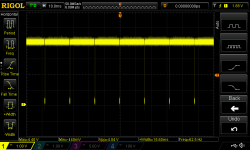Eudimorphodon
Veteran Member
You might be surprised. There isn't any Black magic, only Science and it is not a Rathole either
Okay, but… the whole thing kicking this off was a question about an overshoot on the square wave observed on the scope, and that appears to have been resolved by changing the probe setup. I’m by no means an expert, but that looks like a decent square wave to me now.
Maybe I’m looking at the wrong IC14, but on the Dazzler schematic I pulled up it looks like this point that’s being measured is after the raw output from the colorburst crystal used for master timing is inverted twice; both phases are used, with the un-double-inverted phase providing the main clock signal and this double-inverted one driving some of the final color output. I guess the question I have here is this: what is the working theory you have for the *very small* difference in propagation delay between straight TTL and LS causing some kind of downstream problem? I could maybe see this causing a slight phase shift in the color, maybe, but… do you think it’s not driving the main timing chain “hard enough”?
(I mean, if you really think that little bit of drive you get from straight TTL is such a huge deal for this part of the circuit you could slap a couple weak pull-ups on the two clock phases and see if things just magically get better. Not seeing that as likely, but that would essentially paper over almost all the measurable differences.)
I dunno, it just seems to me that a skipping vertical sync signal is orders of magnitudes removed from this crystal output. You could be missing a *lot* of 3.5something mhz pulses and still be dead on for something that happens *every 1/60th of a second*. And besides, the video output otherwise looks pretty good?
So yeah, feels a lot like a rathole.
Last edited:

